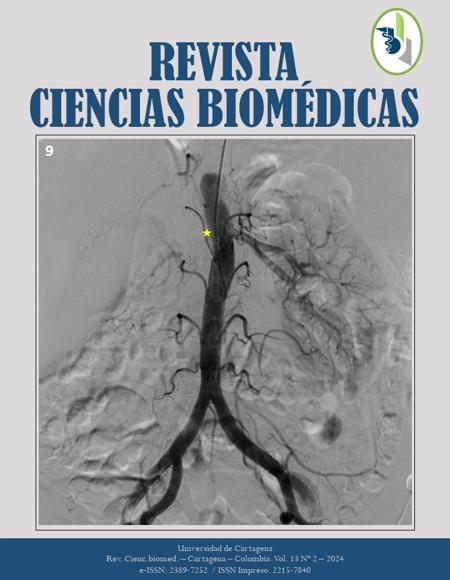Explorando el potencial de reactividad cruzada de DER F 24, un alérgeno de citocromo de Dermatophagoides Farinae: un enfoque bioinformático
Exploring cross reactivity potential of DER F 24, a cytochrome allergen from Dermatophagoides Farinae: a bioinformatic approach
Contenido principal del artículo
Resumen
Introducción: Der f 24, que es un alérgeno caracterizado de Dermatophagoides farinae, es un homólogo de la proteína de unión de ubiquinol citocromo c reductasa (UQCRB). Datos experimentales revelaron que la reactividad de IgE en Der f 24 se concentra en un epítopo ubicado en las posiciones de aminoácidos 1-32, correspondiente a la región N-terminal. Sin embargo, la posible reactividad cruzada entre Der f 24 y otras fuentes alergénicas no ha sido explorada utilizando enfoques experimentales o in silico. Objetivo: en este estudio, utilizando datos experimentales previamente publicados y herramientas bioinformáticas, exploramos posibles alérgenos que reaccionan de manera cruzada con Der f 24 en diversas fuentes alergénicas importantes en los trópicos. Métodos: se realizó una alineación múltiple entre las secuencias de aminoácidos de Der f 24 y fuentes alergénicas comunes (crustáceos, insectos, ácaros, roedores, helmintos y Bos taurus) para explorar la identidad y la homología estructural. Se utilizaron las herramientas in silico ElliPro y BepiPred para predecir epítopos de células B. La herramienta Consurf se utilizó para identificar regiones conservadas entre homólogos. Resultados: se encontraron doce homólogos de Der f 24 en varias fuentes alergénicas como ácaros, insectos, crustáceos y mamíferos, con un promedio de 65% de homología entre ellos. Se predijeron tres epítopos lineales (15-19 GFRK, 48-51 RRLP y 75-80 FLPKEQW) y un epítopo discontinuo (K105, K107, E108, E109, I112, N113), todos ellos conservados entre las UQCRB estudiadas aquí. Finalmente, según el análisis de ConSurf, los epítopos predichos en este estudio están altamente conservados entre la familia de proteínas UQCRB. Conclusión: se encontró reactividad cruzada entre Der f 24 y varios homólogos en fuentes alergénicas como ácaros, insectos y mamíferos, lo que sugiere que Der f 24 es un alérgeno con alto potencial de reactividad cruzada.
Palabras clave:
Descargas
Detalles del artículo
Referencias (VER)
Fernández-Caldas E, Puerta L, Caraballo L. Mites and allergy. Chem Immunol Allergy. 2014;100:234-42.
Acevedo N, Sánchez J, Erler A, Mercado D, Briza P, Kennedy M, et al. IgE cross-reactivity between Ascaris and domestic mite allergens: the role of tropomyosin and the nematode polyprotein ABA-1. Allergy. 2009;64(11):1635-43.
Cantillo JF, Puerta L, Fernandez-Caldas E, Subiza JL, Soria I, Wöhrl S, et al. Tropomyosins in mosquito and house dust mite cross-react at the humoral and cellular level. Clin Exp Allergy. 2018;48(10):1354-63.
Ayuso R, Reese G, Leong-Kee S, Plante M, Lehrer SB. Molecular basis of arthropod cross-reactivity: IgE-binding cross-reactive epitopes of shrimp, house dust mite and cockroach tropomyosins. Int Arch Allergy Immunol. 2002;129(1):38-48.
Ferreira F, Hawranek T, Gruber P, Wopfner N, Mari A. Allergic cross-reactivity: from gene to the clinic. Allergy. 2004;59(3):243-67.
Aalberse RC, Akkerdaas J, van Ree R. Cross-reactivity of IgE antibodies to allergens. Allergy. 2001;56(6):478-90.
Múnera M, Martínez D, Wortmann J, Zakzuk J, Keller W, Caraballo L, et al. Structural and allergenic properties of the Fatty Acid Binding Protein from shrimp Litopenaeus vannamei. Allergy. 2021.
Maleki SJ, Teuber SS, Cheng H, Chen D, Comstock SS, Ruan S, et al. Computationally predicted IgE epitopes of walnut allergens contribute to cross-reactivity with peanuts. Allergy. 2011;66(12):1522-9.
McClain S. Bioinformatic screening and detection of allergen cross-reactive IgE-binding epitopes. Mol Nutr Food Res. 2017;61(8).
Herman RA, Song P. Validation of bioinformatic approaches for predicting allergen cross reactivity. Food Chem Toxicol. 2019;132:110656.
Schein CH, Ivanciuc O, Braun W. Bioinformatics approaches to classifying allergens and predicting cross-reactivity. Immunol Allergy Clin North Am. 2007;27(1):1-27.
Negi SS, Braun W. Cross-React: a new structural bioinformatics method for predicting allergen cross-reactivity. Bioinformatics. 2017;33(7):1014-20.
Cai ZL, Zhang Z, Luo WL, Hou YB, He YS, Chen JJ, et al. Identification of immunodominant IgE epitopes of the major house dust mite allergen Der f 24. Int J Mol Med. 2019;44(5):1888-98.
Hauser M, Roulias A, Ferreira F, Egger M. Panallergens and their impact on the allergic patient. Allergy Asthma Clin Immunol. 2010;6(1):1.
Ayuso R, Lehrer SB, Reese G. Identification of continuous, allergenic regions of the major shrimp allergen Pen a 1 (tropomyosin). Int Arch Allergy Immunol. 2002;127(1):27-37.



 PDF
PDF
 FLIP
FLIP




